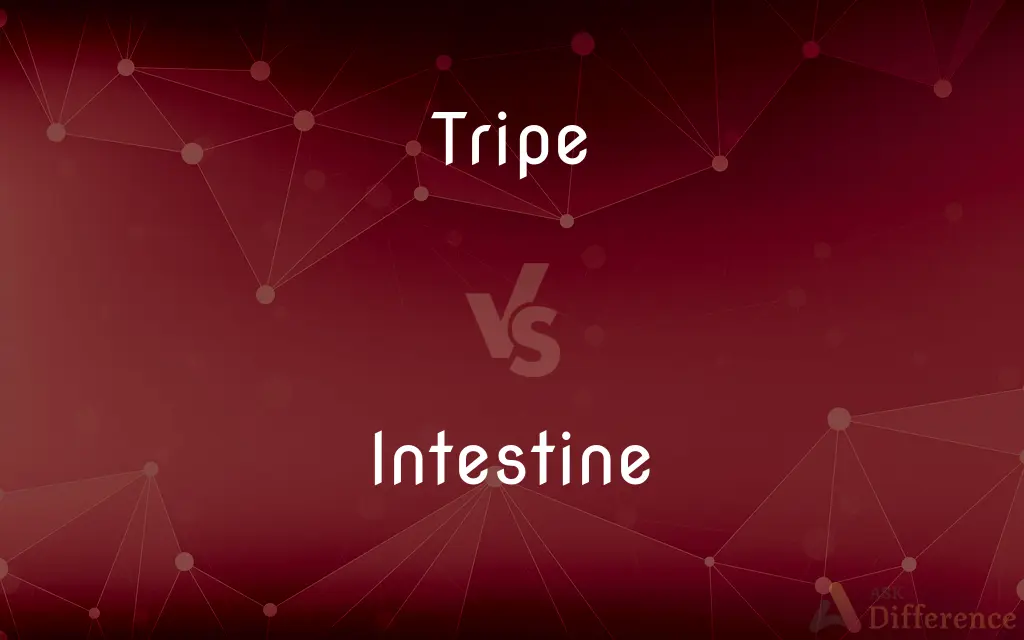Tripe vs. Intestine — What's the Difference?
By Tayyaba Rehman & Urooj Arif — Updated on March 28, 2024
Tripe refers to the stomach lining of ruminants used as food, noted for its chewy texture, while intestine is the digestive tube from stomach to anus in animals, not typically consumed in Western cuisine.

Difference Between Tripe and Intestine
Table of Contents
ADVERTISEMENT
Key Differences
Tripe is a culinary term specifically referring to the stomach lining of ruminants such as cows, sheep, and goats, appreciated for its unique texture and flavor in various global dishes. Whereas, intestine encompasses a broader anatomical category, including the entire digestive tract from the stomach to the anus in animals and humans, and is used in a variety of culinary traditions, though less commonly in Western diets.
Tripe is often prepared through a meticulous cleaning process, followed by slow cooking to achieve its desired tenderness, making it a staple in dishes like menudo and trippa alla Romana. On the other hand, intestines require thorough cleaning and preparation to remove bitterness, used in dishes such as chitterlings or as natural sausage casings, reflecting diverse culinary uses based on their texture and capacity to absorb flavors.
While tripe is mostly associated with the stomachs of cattle, particularly the first three chambers of a cow's stomach, it is celebrated in many cultures for its distinct texture and ability to absorb the flavors of spices and sauces it's cooked with. Intestines, covering a wider range of the digestive system, are valued in cuisines around the world for their versatility, from being grilled, stewed, to stuffed, showcasing a wide spectrum of culinary possibilities.
In terms of nutritional value, tripe is high in protein and minerals such as zinc and iron, making it a nutritious addition to the diet. Intestines, while also protein-rich, are known for their high cholesterol and fat content, necessitating moderation in consumption for health-conscious diners.
The preparation and cultural significance of tripe and intestines vary globally. Tripe is often celebrated in European and Asian cuisines, while intestines have a broader cultural acceptance, including in African, Asian, and Latin American cuisines, illustrating diverse traditions and preferences in their culinary application.
ADVERTISEMENT
Comparison Chart
Definition
The edible lining from the stomachs of various farm animals
The digestive tube from the stomach to the anus in animals
Primary Use
Food, especially in soups and stews
Food, casings for sausages, some regional dishes
Texture
Chewy and tender with proper cooking
Varied, can be chewy or soft depending on preparation
Nutritional Value
High in protein, zinc, and iron
Protein-rich, higher in fat and cholesterol
Cultural Significance
Prominent in European, Asian, and Mexican cuisines
Widely used across many cultures, including African and Asian
Compare with Definitions
Tripe
The stomach lining of ruminants used as food.
He enjoyed a hearty bowl of tripe stew for dinner.
Intestine
The digestive tube from the stomach to the anus.
The anatomy class studied the structure of the intestine.
Tripe
Rich in protein and minerals.
She incorporated tripe into her diet for its high iron content.
Intestine
Can be used as natural sausage casings.
They preferred using natural intestine casings for their homemade sausages.
Tripe
Often considered a delicacy in various cuisines.
In her trip to Florence, she savored the famous trippa alla Romana.
Intestine
Used as food in some cultures.
He tried grilled intestines at the street food market.
Tripe
Requires thorough cleaning before cooking.
The chef spent hours preparing the tripe to ensure its tenderness.
Intestine
Requires careful preparation to ensure cleanliness.
Cleaning the intestines was a crucial step before they could be cooked.
Tripe
Cooked in a variety of ways, including stewing and frying.
They served fried tripe with a spicy dipping sauce.
Intestine
High in cholesterol and fat.
Despite its nutritional value, the intestine is consumed moderately due to its fat content.
Tripe
Tripe is a type of edible lining from the stomachs of various farm animals. Most tripe is from cattle, pigs and sheep.
Intestine
The portion of the digestive tract extending from the stomach to the anus and, in humans and other mammals, consisting of two segments, the small intestine and the large intestine.
Tripe
The rubbery lining of the stomach of cattle or other ruminants, used as food.
Intestine
Internal; civil:the intestine affairs of the nation.
Tripe
(Informal) Something of no value; rubbish.
Intestine
The alimentary canal of an animal through which food passes after having passed all stomachs.
Tripe
The lining of the large stomach of ruminating animals, when prepared for food.
Intestine
One of certain subdivisions of this part of the alimentary canal, such as the small or large intestine in human beings.
Tripe
The entrails; hence, humorously or in contempt, the belly.
Intestine
Domestic; taking place within a given country or region.
Tripe
Something foolish or valueless, especially written works and popular entertainment (movies, television).
Intestine
(obsolete) Internal.
Tripe
An edible lichen, especially rock tripe.
Intestine
Depending upon the internal constitution of a body or entity; subjective.
Tripe
(pejorative) That (what has just been said) is untrue.
Intestine
Shut up; enclosed.
Tripe
The large stomach of ruminating animals, when prepared for food.
How say you to a fat tripe finely broiled ?
Intestine
Internal; inward; - opposed to external.
Epilepsies, fierce catarrhs,Intestine stone and ulcers.
Tripe
The entrails; hence, humorously or in contempt, the belly; - generally used in the plural.
Intestine
Internal with regard to a state or country; domestic; not foreign; - applied usually to that which is evil; as, intestine disorders, calamities, etc.
Hoping here to endIntestine war in heaven, the arch foe subdued.
An intestine struggle . . . between authority and liberty.
Tripe
Lining of the stomach of a ruminant (especially a bovine) used as food
Intestine
Depending upon the internal constitution of a body or entity; subjective.
Everything labors under an intestine necessity.
Tripe
Nonsensical talk or writing
Intestine
Shut up; inclosed.
Intestine
That part of the alimentary canal between the stomach and the anus. See Illust. of Digestive apparatus.
Intestine
The bowels; entrails; viscera.
Intestine
The part of the alimentary canal between the stomach and the anus
Common Curiosities
How do you prepare intestines for cooking?
Intestines must be thoroughly cleaned and sometimes soaked to remove bitterness before cooking.
Can you eat intestine?
Yes, intestines are eaten in many cultures, often prepared grilled, stewed, or as sausage casings.
Is tripe good for you?
Tripe is high in protein and minerals such as zinc and iron, making it nutritious when consumed in moderation.
What is tripe made from?
Tripe is made from the stomach lining of ruminants, like cows and sheep.
Can tripe be eaten raw?
Tripe should not be eaten raw; it requires thorough cooking to ensure safety and tenderness.
Can tripe be fried?
Yes, tripe can be fried, often resulting in a crispy texture outside and tender inside.
What dishes use intestine?
Intestine is used in dishes like chitterlings, grilled intestines, and as casings for sausages.
Is tripe expensive?
Tripe is generally affordable, often considered a budget-friendly ingredient.
What does tripe taste like?
Tripe has a mild flavor, absorbing the tastes of the spices and sauces it is cooked with.
Are intestines high in cholesterol?
Yes, intestines are high in cholesterol and should be consumed in moderation.
Is tripe only from cows?
While cow tripe is the most common, tripe can also come from other ruminants like sheep and goats.
Do all cultures eat intestine?
While not universally consumed, many cultures around the world include intestine in their cuisine.
How long does it take to cook tripe?
Tripe requires long, slow cooking, often several hours, to become tender.
What are the benefits of eating intestine?
Intestines are rich in protein, but due to their high fat and cholesterol content, they offer a mixed nutritional profile.
How do you clean tripe before cooking?
Tripe needs to be cleaned meticulously, often involving soaking and scrubbing, to remove impurities.
Share Your Discovery

Previous Comparison
Samsara vs. Moksha
Next Comparison
Curtsy vs. CurtseyAuthor Spotlight
Written by
Tayyaba RehmanTayyaba Rehman is a distinguished writer, currently serving as a primary contributor to askdifference.com. As a researcher in semantics and etymology, Tayyaba's passion for the complexity of languages and their distinctions has found a perfect home on the platform. Tayyaba delves into the intricacies of language, distinguishing between commonly confused words and phrases, thereby providing clarity for readers worldwide.
Co-written by
Urooj ArifUrooj is a skilled content writer at Ask Difference, known for her exceptional ability to simplify complex topics into engaging and informative content. With a passion for research and a flair for clear, concise writing, she consistently delivers articles that resonate with our diverse audience.















































